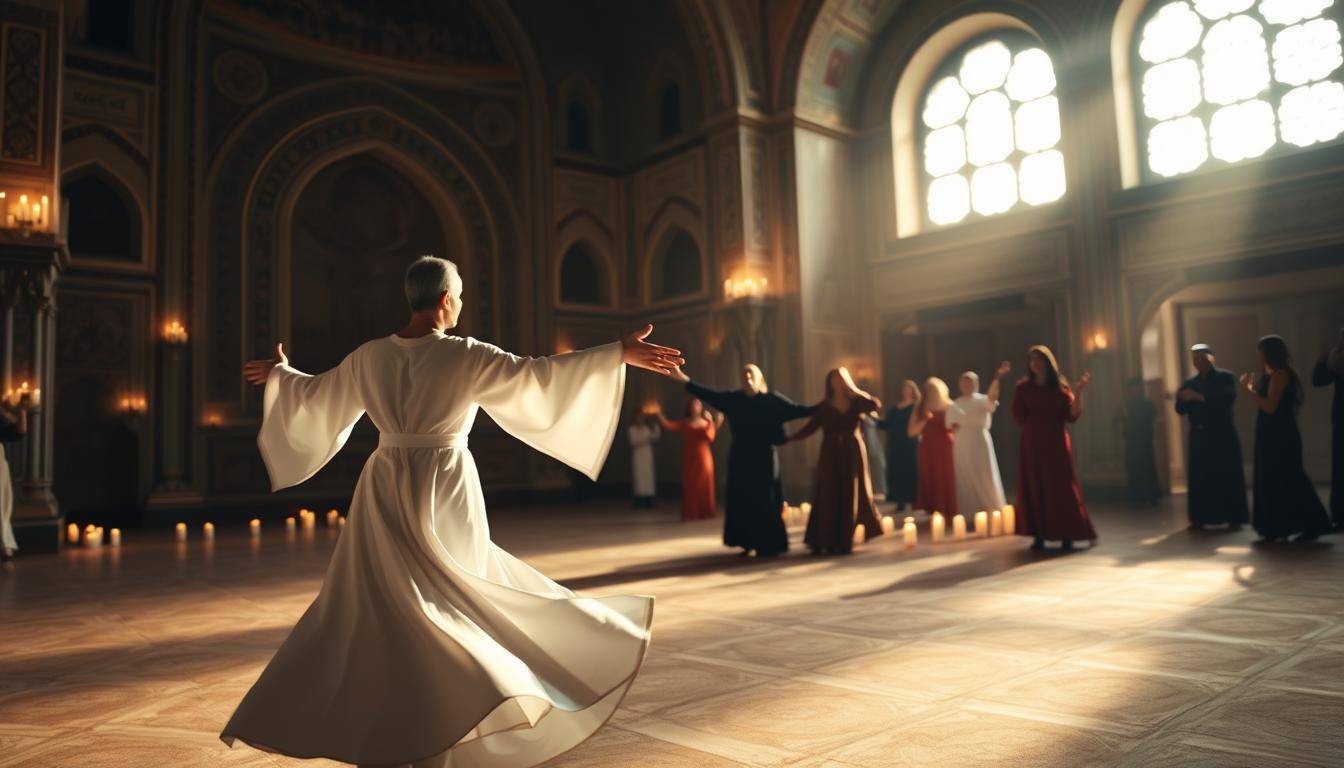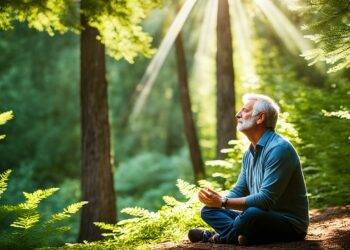“In order to truly understand stillness, one must dance,” wrote the 13th-century poet Rumi. These words capture the essence of a centuries-old practice that blends movement, mindfulness, and meaning. This article explores how a dynamic form of active meditation—rooted in ancient tradition—can unlock profound personal growth and align modern seekers with their deepest aspirations.
Unlike conventional stillness-based techniques, this practice uses rhythmic spinning to quiet mental chatter and awaken spiritual clarity. Originating from mystical teachings, it symbolizes releasing limiting beliefs—like shedding layers—to reconnect with one’s authentic self. Rumi’s poetry often reflects this journey, framing the dance as a metaphor for transcending ego and embracing universal love.
Today, practitioners merge time-tested methods with manifestation principles to amplify intentional living. By harmonizing body and spirit, the ritual becomes a gateway to purpose—guiding individuals toward confidence, creativity, and alignment with their goals. The following sections will break down its transformative mechanics, historical roots, and actionable steps to integrate its wisdom into daily life.
Key Takeaways
- Active meditation combines movement with mindfulness for deeper self-awareness.
- Ancient traditions can enhance modern goal-setting and personal growth strategies.
- Rhythmic practices help quiet mental noise and foster emotional clarity.
- Symbolic rituals, like spinning, represent releasing limiting beliefs.
- This article provides step-by-step guidance to apply these principles practically.
Introduction to the Ancient Practice
In a world that often prioritizes stillness, some traditions teach that purposeful movement can unlock deeper spiritual awareness. This dynamic approach—where physical motion becomes a pathway to mindfulness—has guided seekers for centuries. At its core, it’s about harmonizing energy through intentional action rather than passive observation.
What Is Sufi Whirling Meditation?
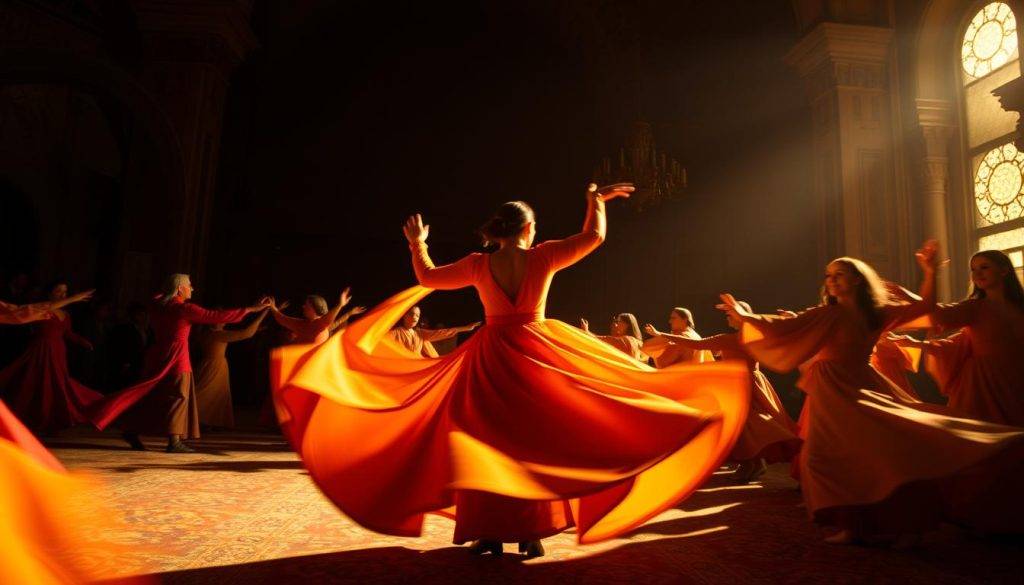
Unlike seated practices focusing solely on breath, this method uses continuous spinning to create a flow state. The right hand typically points upward to receive energy, while the left faces downward—symbolizing giving back to the earth. This balance mirrors the dance between inner reflection and outward expression, creating what modern practitioners in communities like Auroville call “a moving prayer.”
The Journey From Tradition to Today
Rooted in 13th-century teachings, the ritual gained prominence through the poet Rumi and the Mevlevi Order he inspired. Centuries later, its principles resonate with those seeking clarity amid modern chaos. “Every turn feels like shedding old stories,” shares a practitioner from India’s experimental township, highlighting how ancient symbolism adapts to contemporary self-discovery journeys.
Today, the practice remains part of a global spiritual heritage—not as a relic, but as a living tradition. By merging disciplined movement with mindful intention, it continues to shape lives through timeless yet evolving wisdom.
History and Origins of Sufi Whirling
Some of the most enduring traditions begin with a single visionary’s influence. In 13th-century Anatolia, a scholar’s grief transformed into a spiritual revolution. This became the foundation for a ritual now recognized worldwide.
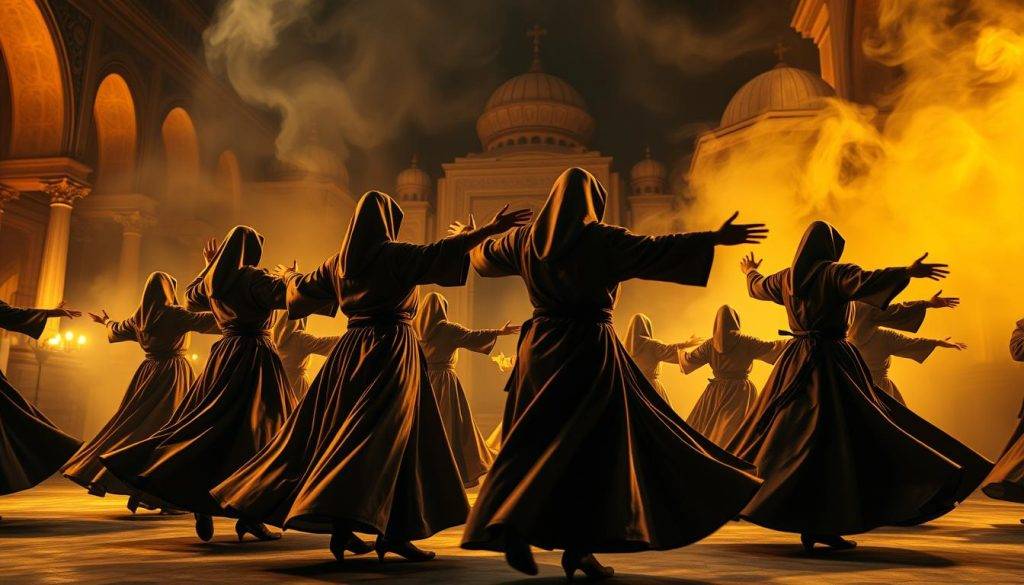
Rumi and the Birth of a Sacred Ritual
The famous poet Rumi channeled loss into creative awakening after meeting wandering mystic Shams Tabrizi. Their bond inspired ecstatic movements symbolizing unity with the divine. Followers later codified these spontaneous gestures into structured rotations.
By turning continuously, “the seeker becomes both compass and map,” wrote Rumi. His verses framed the dance as a metaphor for planetary orbits—a physical prayer dissolving boundaries between earthly and eternal.
The Guardians of a Living Legacy
Rumi’s son established the Mevlevi Order, ensuring his father’s teachings survived through disciplined practices. Initiates trained for 1,001 days to master symbolic gestures:
| Era | Key Figures | Core Practices | Symbolism |
|---|---|---|---|
| 13th Century | Rumi, Shams Tabrizi | Spontaneous rotations | Cosmic harmony |
| Modern Day | Mevlevi teachers | Structured ceremonies | Inner-outer balance |
Today, UNESCO recognizes the whirling dervishes as cultural heritage. Their white robes represent spiritual rebirth, while the felt hats symbolize tombstones to ego. From Istanbul to global workshops, this tradition remains a bridge between ancient wisdom and contemporary seekers.
The Spiritual Philosophy Behind the Dance
What transforms a physical ritual into a gateway for profound transformation? At its core, this practice merges motion with meaning—a dance where every spin becomes a conversation between the visible and invisible worlds.
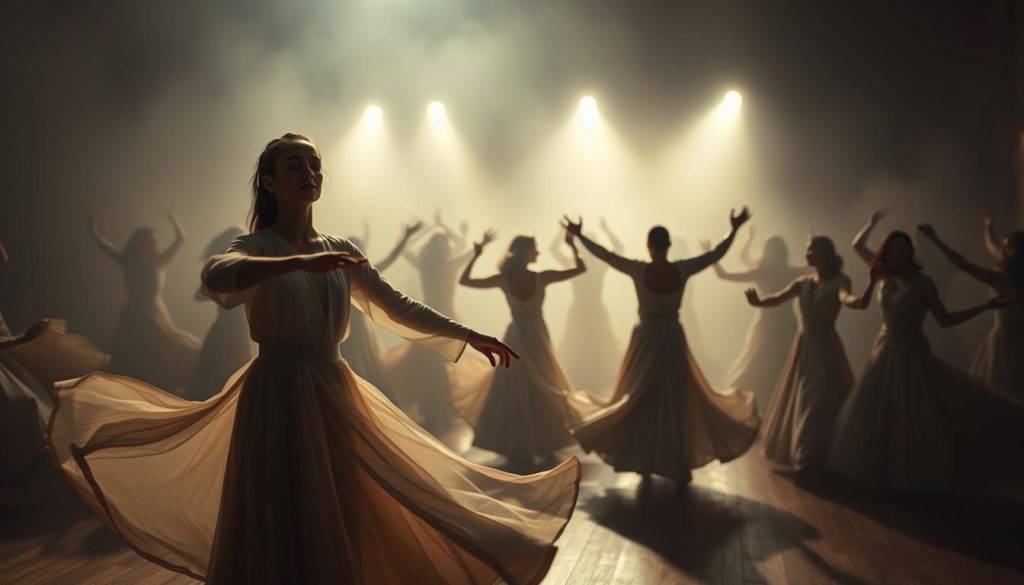
Exploring Divine Love and Inner Peace
The circular motion symbolizes life’s eternal cycles—birth, growth, and return to source. As participants turn, they mirror celestial patterns, creating harmony between mind and soul. “Love is the bridge between you and everything,” wrote Rumi, emphasizing how movement dissolves barriers to inner peace.
This active meditation redirects focus from external distractions to the heart’s rhythm. By releasing attachment to outcomes, practitioners report diminished ego influence—like shedding heavy armor to embrace lightness. One modern teacher describes it as “learning to dance with life instead of wrestling it.”
Active Meditation: From Ego to Essence
Unlike passive techniques, this method uses centrifugal force to quiet mental noise. The body’s rotation creates a natural trance state, shifting awareness from ego-driven thoughts to universal connection. Studies show rhythmic movement increases theta brain waves—linked to intuition and creativity.
| Aspect | Ego-Centric State | Essence-Aligned State |
|---|---|---|
| Focus | External validation | Inner truth |
| Energy | Scattered | Centered |
| Outcome | Fear-based | Love-driven |
The table above illustrates the transformative shift. Through disciplined practice, participants cultivate resilience—not by fighting challenges, but by flowing with life’s currents. As one practitioner notes: “It’s not about becoming someone new, but remembering who you’ve always been.”
Sufi whirling meditation: Techniques and Practices
Every gesture in this ancient ritual carries precise intention, transforming simple motions into pathways for spiritual awakening. The techniques blend disciplined form with symbolic meaning, creating a living dialogue between the body and higher consciousness.
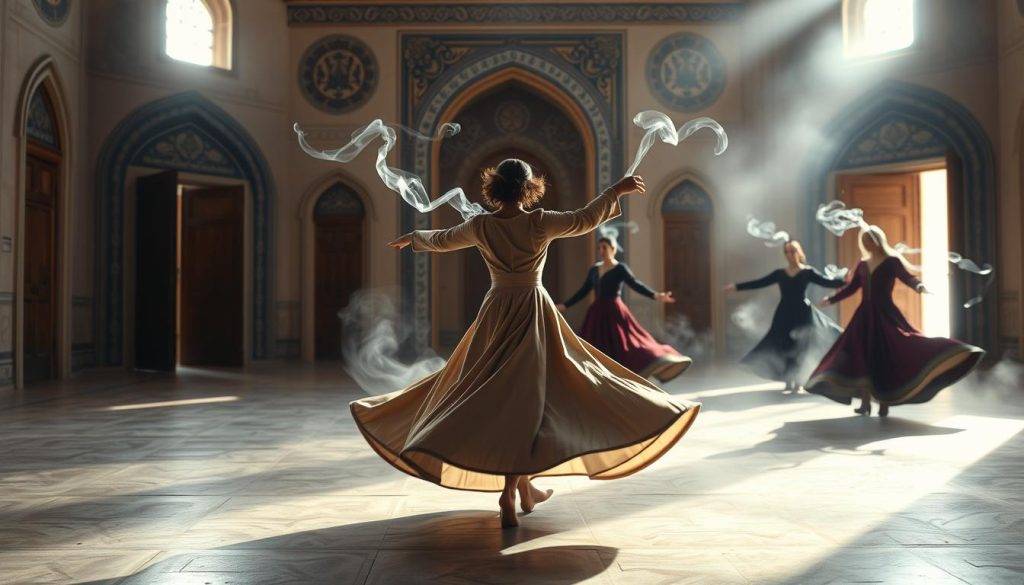
Understanding the Symbolism Behind the Movements
The right hand faces upward to receive divine energy, while the left points downward—symbolizing earthly grounding. This posture embodies balance, teaching practitioners to harmonize giving and receiving. As the body rotates, the flowing skirt mirrors the release of limiting patterns, visually echoing the soul’s ascent.
Central to the practice is maintaining a fixed gaze point during spins. This stabilizes focus, training the mind to stay centered amid external distractions. “The axis of your spine becomes your compass,” notes a Mevlevi instructor, highlighting how posture aligns intention with action.
Beginners should prioritize safety by starting with slow rotations and barefoot grounding. Strengthening core muscles enhances stability, while breath awareness prevents dizziness. Over time, these techniques cultivate resilience—both physical and emotional—as the dance evolves from mechanical steps to fluid self-expression.
Mastery lies not in perfect spins, but in how movement becomes a mirror for inner growth. By synchronizing breath, body, and symbolic gestures, the practice transforms into a moving meditation—one turn at a time.
The Role of Music and Movement in Sufi Practice
Harmony between sound and motion lies at the heart of many spiritual traditions. In this practice, melodies and gestures merge to create a sacred dialogue—one that elevates awareness beyond ordinary perception. The interplay of rhythm and posture transforms simple actions into pathways for transcendence.
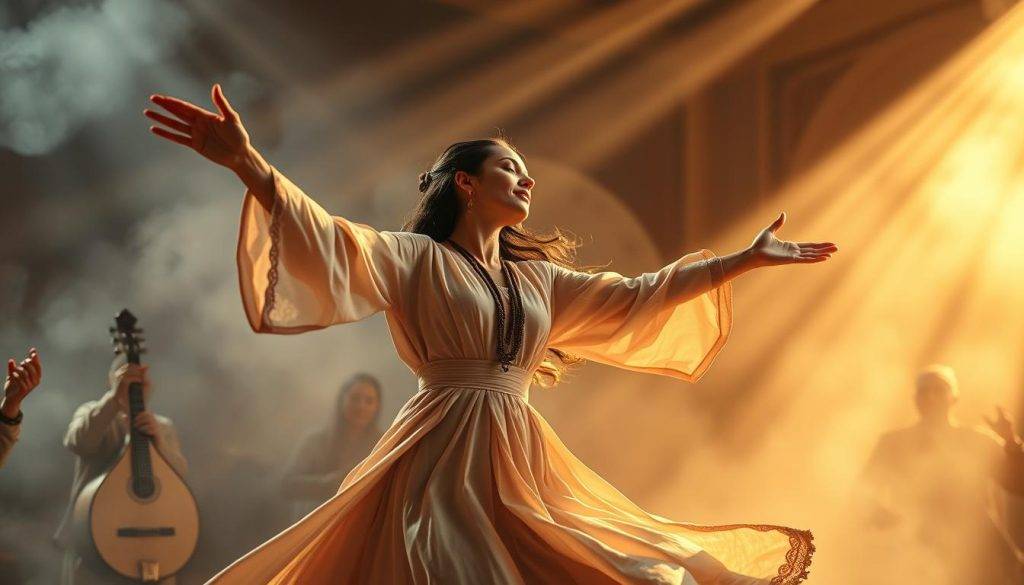
How Traditional Music Sets the Mood
Ancient instruments like the ney (reed flute) and frame drums anchor the experience. Their haunting tones and steady beats guide the pace of rotations, syncing breath with intention. “The music isn’t background noise—it’s the compass,” explains a Turkish musician. Rhythmic patterns help quiet mental chatter, allowing practitioners to enter meditative states more deeply.
Studies suggest repetitive auditory cues reduce beta brain waves, easing the shift into trance-like focus. This auditory framework ensures movements remain fluid yet disciplined—a balance critical for maintaining physical and spiritual alignment.
The Dance as a Form of Worship
Extended arms play a key role in the dance. The right arm reaches skyward, symbolizing receptivity, while the left points earthward to ground energy. This posture fosters balance, both physically and metaphorically, as practitioners embody the flow between giving and receiving.
Every spin becomes an act of devotion when paired with sacred melodies. The synergy of music and movement dissolves separation between participant and ritual, turning motion into prayer. Over time, this fusion cultivates a profound sense of unity—not just with the self, but with the universal rhythms that govern all life.
A Step-by-Step Guide to Whirling Meditation
Intentional preparation transforms physical spaces into sacred environments for growth. By aligning your surroundings with mindful practices, you create conditions where movement becomes a tool for clarity. Let’s explore how to begin safely while honoring the body’s wisdom.
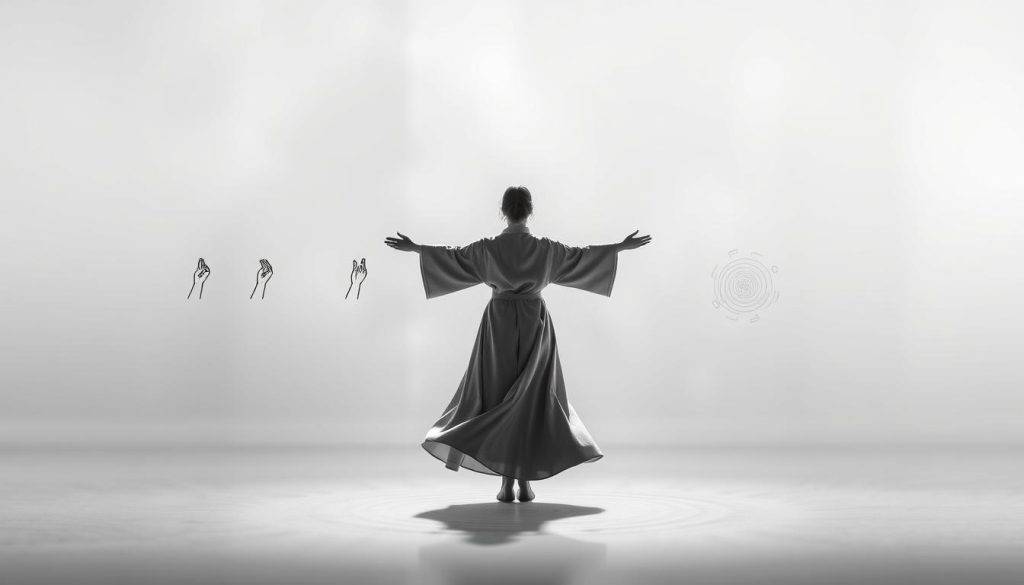
Preparing Your Space and Mind
Start by clearing a 6-foot-wide area free of furniture. Remove sharp objects and ensure proper lighting. Stand barefoot or wear socks with grips to prevent slips. Begin with three deep breaths—inhale through the nose, exhale through pursed lips—to calm the mind.
Choose instrumental music or set a timer for 5-10 minutes. Place your right palm upward and left downward, elbows slightly bent. Fix your gaze on a stationary object to maintain balance during spins.
Practical Safety Tips and Preparation
Build endurance gradually. First-time practitioners should aim for 2-3 rotations before pausing. Keep sessions under 10 minutes initially—overexertion disrupts the body’s natural rhythm. After spinning, sit cross-legged for 60 seconds to reorient.
| Focus Area | Beginner Practice | Advanced Practice |
|---|---|---|
| Posture | Feet shoulder-width apart | Fluid weight shifts |
| Duration | 5-minute sessions | 15-minute sessions |
| Footwear | Non-slip socks | Barefoot grounding |
Post-session hydration and light stretching prevent dizziness. As one instructor advises: “Respect your limits—growth happens through consistency, not force.” These techniques ensure active meditation remains both transformative and sustainable.
Techniques and Tips for Beginners
How does a beginner transform tentative steps into fluid motion? The answer lies in trusting the body’s innate wisdom. Before attempting structured forms, many teachers recommend free-flowing movement to discover personal rhythms. This approach builds familiarity with physical mechanics while nurturing creative expression.
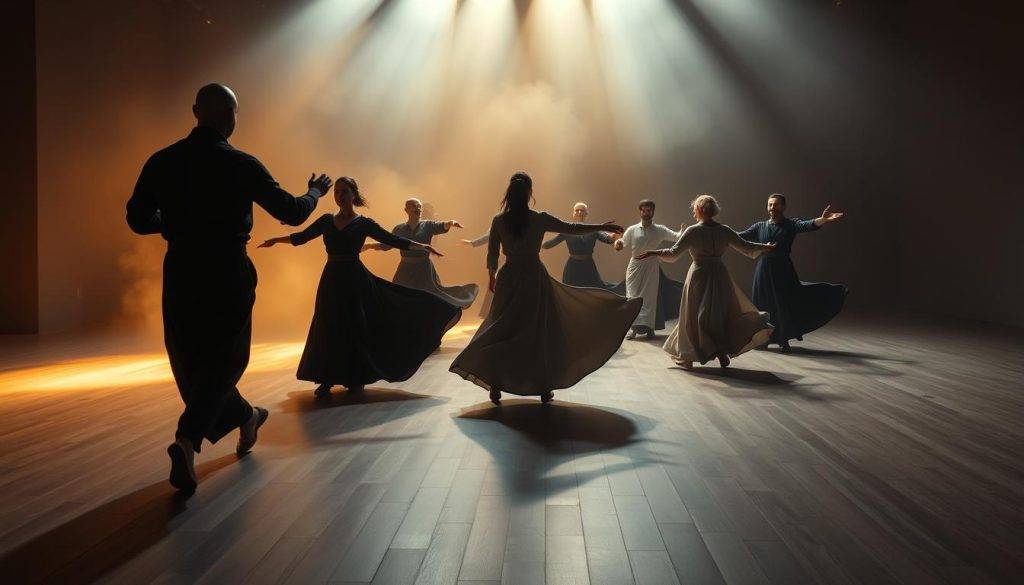
Finding Your Natural Rhythm
Start by swaying gently side-to-side, letting your arms float naturally. Notice how weight shifts between feet—this awareness forms the foundation for controlled spins. Gradually introduce quarter-turns, keeping your gaze fixed on a stationary point. “Progress isn’t measured in rotations, but in how connected you feel,” advises a movement coach from Los Angeles.
| Element | Beginner Focus | Advanced Focus |
|---|---|---|
| Hand Position | Palms facing thighs | Sky-earth energy flow |
| Footwork | Small pivots | Continuous spirals |
| Breath | Steady inhales/exhales | Synced with rotations |
Building Confidence Through Practice
Consistency trumps duration. Five-minute daily sessions help the body adapt faster than weekly marathons. Record your progress in a journal—note improvements in balance or emotional shifts. Over time, these observations reveal patterns that boost self-assurance.
Celebrate micro-wins: completing three clean turns or maintaining steady breathing. One practitioner shares: “When I stopped comparing my way to others’, everything clicked.” Remember—every experience shapes your unique path. Trust the process, and the movement will meet you where you are.
Embracing Physical and Emotional Liberation
True freedom often begins where words end and movement speaks. This practice teaches that releasing stored tension requires more than introspection—it demands embodied action. By merging disciplined motion with mindful awareness, participants unlock layers of emotional resistance.
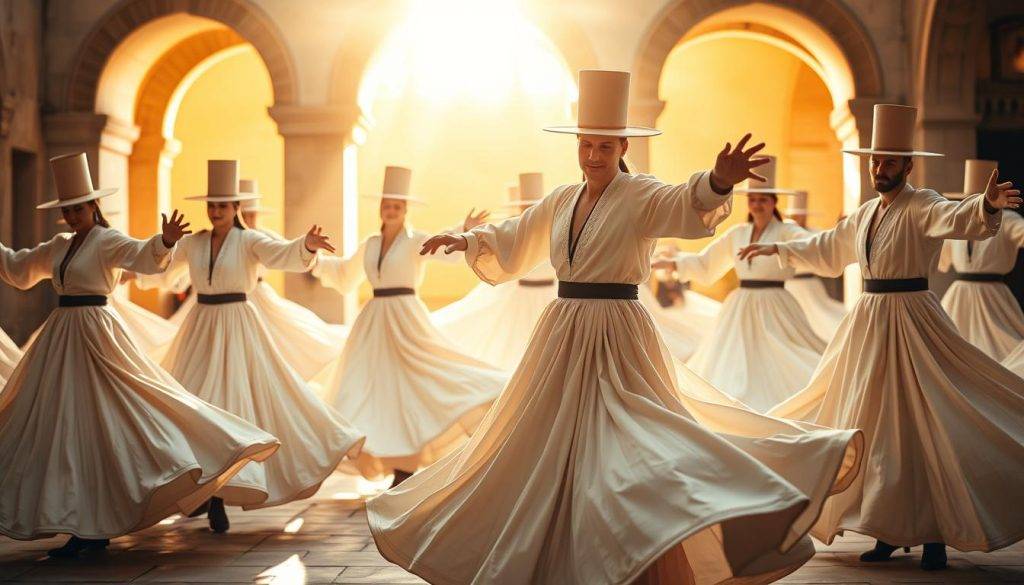
Mastering Emotions Through Movement
Coordinating spins with breath awareness creates a feedback loop between body and mind. As rotations accelerate, mental chatter fades—making space to observe feelings without attachment. “The dance becomes a mirror,” explains a teacher from Turkey. “What you resist in stillness, you release in motion.”
Practitioners learn to identify emotional blockages through physical sensations. Tight shoulders might signal buried stress, while unsteady footing could reflect self-doubt. Addressing these cues mid-spin cultivates real-time resilience.
- Focus on fluid arm movements to soften rigid thought patterns
- Match breath rhythm to footwork for grounding during emotional surges
- Visualize releasing heaviness with each rotation
The whirling dervishes exemplify this transformative process. Their centuries-old ceremonies demonstrate how sustained spinning can dissolve the ego’s grip, fostering profound connection with universal rhythms. Modern adaptations retain this core philosophy while accommodating individual needs.
| Before Practice | After Practice |
|---|---|
| Scattered focus | Centered awareness |
| Emotional turbulence | Calm clarity |
| Separation from world | Harmonious connection |
One participant shares: “It’s like hitting a reset button for my nervous system—the world feels different when I stop fighting myself.” Through consistent practice, the movement becomes both metaphor and method for lasting liberation.
Sufi Whirling Meditation in the Modern World
Ancient rituals thrive when they evolve alongside human needs. Communities worldwide are reimagining sacred movement for contemporary life, proving timeless wisdom can coexist with 21st-century demands. “Tradition isn’t a cage—it’s a compass,” notes a teacher from Auroville, where weekly workshops blend ceremonial spinning with modern mindfulness techniques.
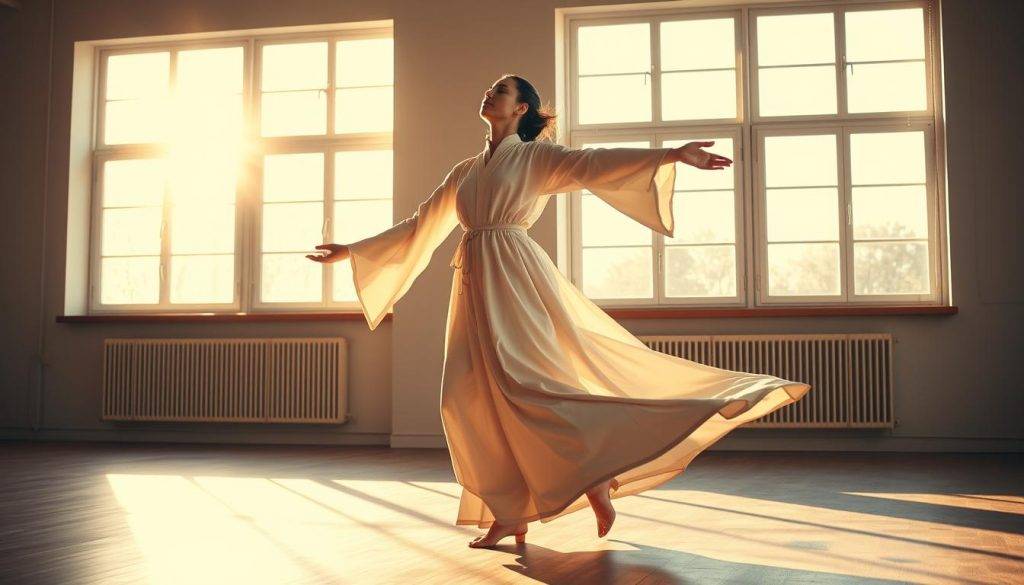
Adapting Ancient Practices for Today’s Lifestyle
Urban studios now offer 30-minute sessions tailored for busy schedules. Participants learn modified rotations that fit small apartments while preserving core principles. Breath-focused warm-ups replace lengthy rituals, making the practice accessible without diluting its spiritual roots.
Safety innovations also bridge old and new. Non-slip mats prevent falls during spins, and apps provide guided audio tracks featuring traditional instruments. These adaptations let people honor the body’s limits while exploring transformative movement.
| Traditional Element | Modern Adaptation |
|---|---|
| Hours-long ceremonies | 20-minute focused sessions |
| Group monastic settings | Virtual global communities |
| Fixed choreography | Personalized movement flows |
Retreat centers from California to Bali integrate spinning with yoga and journaling. One participant shares: “The connection between physical motion and mental clarity feels vital in our screen-dominated world.” By honoring both history and innovation, this living tradition continues to help people find balance amid today’s relentless pace.
The Transformative Power of the Whirling Experience
True transformation often begins where control ends. The experience of surrendering to circular motion creates a profound shift—one that rewires how individuals relate to their self and surroundings. By releasing the need to direct every outcome, practitioners discover a deeper alignment with life’s natural flow.
Releasing the Ego for Inner Growth
Letting go of ego-driven narratives allows space for authentic growth. “The dance taught me to stop overthinking and trust my body’s wisdom,” shares a practitioner from New York. This release often manifests as heightened creativity and resilience in daily challenges.
Research shows repetitive movement reduces activity in the brain’s default mode network—the area linked to self-referential thoughts. As mental chatter fades, individuals report feeling more connected to their core values rather than external expectations.
| Ego-Driven Patterns | Essence-Led Outcomes |
|---|---|
| Fear of failure | Curiosity-driven action |
| People-pleasing | Authentic self-expression |
| Rigid self-image | Fluid personal evolution |
Connecting Mind, Body, and Spirit
The practice creates a tangible bridge between physical sensation and spiritual awareness. One participant describes it as “hearing my soul’s voice through my body’s movements.” This harmony fosters clarity in decision-making and emotional regulation.
Regular engagement strengthens neural pathways between the prefrontal cortex and limbic system. Over time, this connection helps practitioners respond to stress with calm intention rather than reactive habits.
Many find the journey mirrors lessons in Sufi wisdom for inner peace, where surrender becomes a gateway to empowerment. As one teacher summarizes: “It’s not about spinning perfectly—it’s about spinning with love for who you’re becoming.”
Rediscovering Ancient Traditions Through Dance
Cultural heritage survives when communities breathe new life into ancestral wisdom. The flowing white robes and tall hats of ceremonial dancers aren’t costumes—they’re living symbols of a tradition that has spun through centuries. “Our movements carry the whispers of those who danced before us,” explains a modern practitioner from Istanbul.
The swirling skirt in these rituals does more than create visual poetry. Its circular flare mirrors planetary orbits, embodying humanity’s quest to understand cosmic order. This dance form transforms individual motion into collective memory—each rotation honoring generations who preserved its sacred geometry.
Contemporary adaptations show how ancient practices stay relevant. Urban studios blend traditional spins with mindfulness exercises, while global workshops teach the whirling dervishes’ symbolism through accessible movements. “Spinning around isn’t about losing yourself—it’s finding connection across time,” notes a New York instructor.
| Historical Symbol | Modern Interpretation |
|---|---|
| White robe | Purity of intention |
| Tall hat | Transcending ego |
| Circular motion | Life’s cyclical nature |
This tradition invites everyone to explore movement as cultural dialogue. Whether in sacred spaces or living rooms, spinning around becomes a bridge between eras. As one participant reflects: “When I dance, I’m speaking a language older than words.”
Personal Insights and Transformational Journeys
Personal growth often reveals itself through stories of those who’ve walked the path before us. Through disciplined motion and mindful surrender, individuals discover profound shifts in how they navigate life’s challenges. Below, practitioners share how this practice reshaped their perspectives—and their daily realities.
Testimonials from Practitioners
“The first five minutes always felt impossible,” admits Mara, a graphic designer from Colorado. “But once I stopped fighting the spins, clarity rushed in like a wave.” Her journey mirrors others’ experiences—initial dizziness giving way to emotional breakthroughs. Another participant, David, notes how group performances taught him to trust his body’s rhythm: “It’s not about perfection. It’s about showing up, even when you wobble.”
Lessons Learned on the Path
Common themes emerge from these stories:
- Motion as metaphor: Spinning becomes a mirror for overcoming stagnation
- Rhythm over results: Short daily sessions (10-15 minutes) build resilience faster than sporadic marathons
- Performance as practice: Each rotation reinforces self-trust, not external validation
One teacher summarizes: “Your journey isn’t measured in rotations, but in how you carry the dance into your life.” Whether navigating career shifts or creative blocks, practitioners report heightened intuition—proof that growth thrives where movement and meaning intersect.
Conclusion
Centuries-old wisdom meets modern seekers in a dance where motion becomes metaphor. By releasing the ego’s grip—symbolized by the swirling white skirt—this practice cultivates peace through surrender. The raised right hand, open to receive, mirrors our capacity to embrace life’s blessings while staying grounded.
Unity of mind, body, and spirit lies at its heart. Studies show rhythmic spinning quiets mental noise, creating space for joy and clarity. Like Rumi’s followers, today’s practitioners discover that purposeful movement fosters connection—to self, others, and the earth.
These practices offer more than historical curiosity. They provide a living bridge between ancient tradition and contemporary needs. Whether through brief daily spins or ceremonial gatherings, the state of flow remains accessible to all willing to turn inward while moving outward.
Ready to transform stillness into action? Explore how active meditation can align your way of being with deeper purpose. Let each rotation remind you: growth happens when we spin with intention, not despite the motion.
FAQ
How does spinning connect to spiritual awakening?
The circular motion symbolizes cosmic orbits and the soul’s journey toward divine unity. By releasing attachment to physical reality, practitioners access heightened states of awareness where ego dissolves into universal consciousness.
Can this practice help with stress reduction?
Yes—the rhythmic rotation creates a moving meditation that calms mental chatter. Many report improved emotional balance as the dance channels energy away from anxiety into purposeful movement.
Is special attire required for beginners?
A> While traditional dervishes wear symbolic skirts, newcomers can start with loose, comfortable clothing. Bare feet or flexible shoes enhance grounding during rotation.
What role does music play in the experience?
Live ney flute and frame drum rhythms guide the dancer’s tempo, creating an auditory anchor that harmonizes breath, motion, and intention. The melodies often mirror Rumi’s poetry about transcendence.
How long should sessions last for new practitioners?
Start with 3–5 minute intervals, gradually increasing as dizziness decreases. Focus on posture—arms raised right palm upward, left pointing downward—to maintain alignment during spins.
Are there modern adaptations for home practice?
Contemporary teachers emphasize intention over perfection. Simplified rotations in quiet spaces, paired with breathwork, let anyone explore this path without formal training.
Does the dance have ties to specific religions?
Rooted in Islamic mysticism, the Mevlevi tradition welcomes all seeking connection. Its universal themes of love and surrender resonate across spiritual backgrounds today.
























































